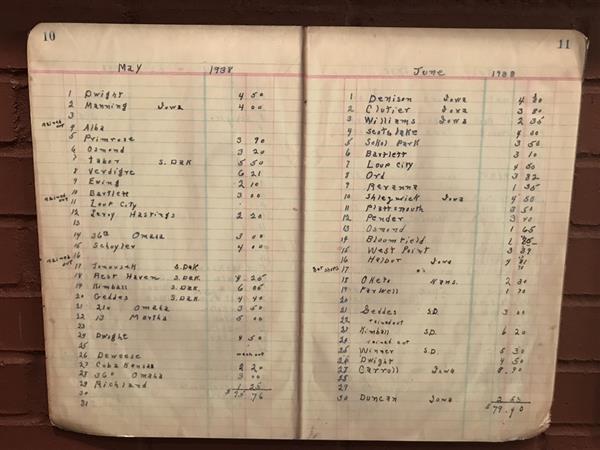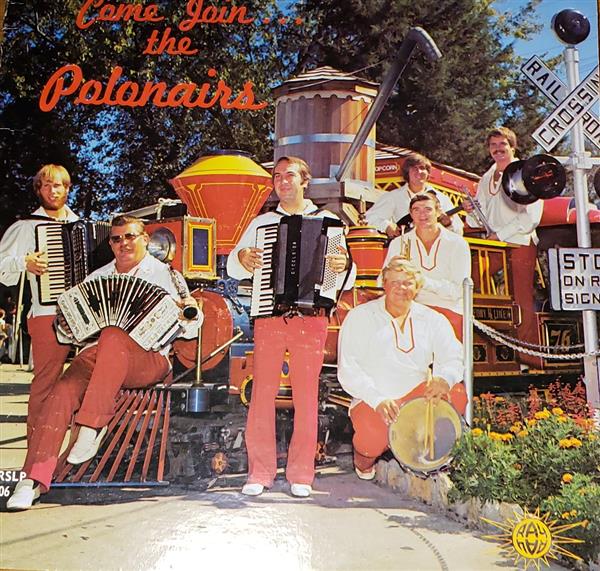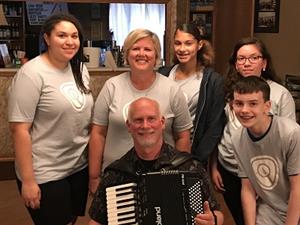Making Invisible Histories Visible
Page Navigation
- Making Invisible Histories Visible
- Lesson Plans and Resources
- iBooks on Omaha and Nebraska History for Primary Students
- Omaha Mapping Projects
-
African American Histories
- African American Artists
- African American Athletes & Facilities
- African American Churches
- African American Civil Rights Organizations - 1950s-1960s
- African American Civil Rights
- African American Contributions to Jazz, Gospel, Hip-Hop
- African American Dramatic Arts
- African American Education - Dorothy Eure & Lerlean Johnson
- African American Educators & Education
- African American Firefighters
- African American Homesteaders
- African American Law Enforcement
- African American Migration to Omaha
- African American Musicians of Omaha
- African American Newspapers
- African American Owned Businesses
- African American Politicians
- African American Social Life
- African American Workers at Omaha's Railroads & Stockyards
- African American Workers at the Naval Ammunition Depot in Hastings
- African Americans in the Civil War
- African Americans in Vietnam
- Charles B. Washington - Journalist and Civil Rights Leader
- Elizabeth Davis Pittman - Lawyer/Judge
- Green Book Omaha
- Marlin Briscoe - Professional Football Player
- Native Omaha Days
- Nebraska's Role in the Underground Railroad
- Sen. Edward Danner - Politician & Civil Rights Activist
- Sudanese Refugees
- Tuskegee Airmen
- European and Asian Immigrant Histories
-
Historic Neighborhoods & Buildings
- 24th and Binney/Wirt/Spencer Streets
- 24th and Lake Streets
- Central Park Neighborhood - 42nd and Grand Avenue
- Dahlman Neighborhood - 10th and Hickory Streets
- Hartman Addition Neighborhood - 16th and Williams Streets
- Indian Hills/Southside Terrace Neighborhood - 30th and Q Streets
- Jefferson Square Neighborhood - 16th and Chicago Streets
- Long Neighborhood - 24th and Clark Streets
- Orchard Hill Neighborhood - 40th and Hamilton Streets
- Smithfield Neighborhood - 24th and Ames Avenue
- St. Mary's Neighborhood - 30th and Q Streets
- Latino Histories
- Music Histories
-
Native American Histories
- Black Elk and John G. Niehardt
- Chief Standing Bear and Susette La Flesche Tibbles
- Dr. Susan LaFlesche Picotte - Native American Doctor
- Native American Education and Boarding Schools
- Native Americans in the Military
- Pre-statehood Interaction of Native Americans and Europeans
- Preserving Native American Tradition
- Restoring the Ponca Tribe
- The American Indian Movement in the 1960s and 1970s
- The Indian Congress at the 1898 Trans-Mississippi Exposition
- The Omaha Native American Indian Tribe
- OPS Elementary School History
- Redlining in Omaha
- Nebraska's Role in the Underground Railroad
- The 1898 Trans-Mississippi Exposition
Polka
-
How is polka connected to the culture and history of Omaha?
Happy Music for Happy People: Polka in Omaha
-
The history of polka music and dance reaches far beyond Omaha, including cities like New York, Cincinnati, and New Orleans. Brought to the United States from Europe by groups such as Czech, Slovak, Polish, and German immigrants, polka is deeply rooted in heritage and memories of the homeland. While each of these groups have different styles of polka, they all deal with the immigrant experience and the preservation of cultural and social identity.
Polka’s shifting popularity reflects not only changes in popular culture like the emergence of Rock ‘n' Roll in the 1900s, but also the ever-changing immigrant communities of South Omaha. In this city especially, polka is kept alive through festivals and community parishes, where the community is brought together through song and dance. With this upbeat music, local polka musicians share and preserve their heritage, while creating a music scene that welcomes all members of the Omaha community.
Published during the Summer of 2018
Happy Music for Happy People: Polka in Omaha, is about polka's history in South Omaha and its importance to the preservation of Eastern European heritage. Those interviewed in the documentary include John Szalewski, Bob Zagozda, Jeff Janda, and Ken Janak. The documentary can also be viewed on YouTube.
Eddie Janak Band Job Ledger
-
Eddie Janak was a popular and influential Czech American polka musician and bandleader from Omaha during the mid-20th century. The Janek family produced a number of other prominent polka musicians, as well. After his untimely death in 1973, Eddie Janek was elected to the Nebraska Polka Hall of Fame in 1976. This job ledger, from May and June of 1938, shows the 50 places Janak’s band played and how much they were paid to perform at each location. The ledger indicates that Janak had regional popularity beyond Nebraska in places like Iowa, South Dakota and Kansas. (Image Courtesy of the Czech & Slovak Museum, Omaha, Nebraska)

The Polish Home
-
The Polish Home was established in 1936 on South 25th and L streets. It was a social hall for Polish immigrants, most of whom came to Omaha to work in the stockyards during the late-19th and early-20th century. In a city filled with many competing ethnic groups, the Polish Home was established to help Polish immigrants maintain and practice their “customs, traditions, folklore, dances and music.” Though far from their homeland, here, Polish immigrants felt at home, as well as a sense of community and support for their traditional identity. Over the course of the 20th century, new waves of immigrants have come to Omaha seeking new opportunities and settled in South Omaha. In 2018, South Omaha is home to a fast-growing Latino population, particularly, but not exclusively, Mexican-Americans. In June 1998, the Polish Home was sold to El Museo Latino, which is dedicated to preserving the history, customs, traditions, folklore, dances and music of Omaha Latinos. The Polish Home relocated to Papillion, Nebraska, an indication of the ever-changing ethnic landscape of our city. (Image Courtesy of The Polish Home)

Polonairs Album
-
This is an album cover of The Polonairs, a popular Omaha polka band that recorded two albums. “Come Join…the Polonairs” was recorded in one six-hour session in 1976, using traditional polka instruments, including three accordions, two trumpets, a clarinet, violin, guitar and drum. The Polonairs performed across the Midwest and even had a fan-club that numbered around 200 members, who also wore matching clothing at concerts. This illustrates that polka was fun, upbeat, happy dance music that played an important role in building and maintaining community and ethnic identity. (Image Courtesy of John Szalewski)

Additional Information
-
Despite polka’s major influence on American music culture in the mid-17th and 18th centuries, its story begins across the Atlantic in Eastern Europe. While polka’s exact origins are unknown, it is widely accepted that polka was a variation on earlier Bohemian dances and Polish folk traditions. It is likely that the polka fad began in Prague in 1835, then spread to nearby Vienna in 1839, finally establishing itself in Paris and London in 1844. Polka took the world by storm and as the popularity of this upbeat music increased, it was introduced to the English elite, who in turn introduced it to the United States.
In the 1840s, polka mania settled in New York City, where this exciting and unfamiliar dance was featured on Broadway at Niblo’s Garden. Polka’s following remained strong through the 1840s in New York, but took longer to reach the rest of the country. Through the buzz created by newspaper articles and published sheet music, the 1850s saw polka’s migration to other American cosmopolitan centers like Baltimore, Philadelphia, Cincinnati, Louisville, and New Orleans. Popular among the working classes in dance halls and the ballrooms of polite society, polka was a part of mainstream American popular culture throughout the 1850s and 1860s. However, with the influx of immigrants in the late 19th century, Polka’s connection to Americanism was replaced by its association with the heritage of European immigrants.
The 1850s also saw the introduction of polka to Omaha as the Eastern Europeans fled worsening economic conditions in Bohemia and Moravia. Drawn to Nebraska by the promise of large tracts of farmland, these immigrants brought from their homelands a love for polka music that was otherwise rapidly decreasing in the United States. Mass emigration from these parts of Eastern Europe began to end in the late 19th century. Yet, with the invention of squeezebox accordions and records that could be played on the radio and at home, polka’s following in the Midwest stayed strong. In Omaha, polka’s presence settled in South Omaha, which was a melting pot for immigrants, drawn to that part of the city by jobs in the world’s largest stockyards, packing houses, and breweries. These Eastern European immigrants played polka at festivals, weddings, and at home to both preserve their memories of the homeland and to maintain their communities in the United States. Aside from South Omaha parishes like Saint Stanislaus and Immaculate Conception, polka was also played at the Polish Home at 25th and L streets, Sokol Hall on 13th and Martha streets, and the Starlite Ballroom in Wahoo, Nebraska. The Starlite alone used to draw in 800 people every Saturday night in the 1960s and ‘70s for polka dances, a testament to this music’s popularity in Omaha.
While polka saw its heyday in Omaha in the 1960s and ‘70s, its popularity declined in Nebraska in the 1980s with the farming crisis. This crisis paired with the increasing popularity of rock music and the rise of disc jockeys diminished the need and want for live bands, including polka. However, while polka is not as prevalent in Omaha as it once was, local musicians still see it as integral to preserving their heritage through lyrics and dance, while also sharing a little happiness with their communities.
2018 MIHV Project
Student Reflections
-
"Confidence and communication were the most difficult parts, but I suggest going to this program if you can, to learn those skills and have fun."
- Cameron B.
"I learned about myself, especially to open up more, because I'm so shy. I would say I have grown through this project."- Amari J.
"One thing I enjoyed about the program was being able to discover hidden history and being able to share it with the community."- Sara C.
Resources
-
Ceremony. Sokol Omaha Polka Hall of Fame, 8 July 2017
Czernikowski, Roy S. The Accordion and the Polka in Polish-American Ethnic Music.
Fedinetz-Adomshick, Heidi D. “Let’s Polka! The Polka, Its Function and Place in Different Cultures.”
Czech & Slovak Educational Center and Cultural Museum
Leary, James P. “Czech- and German-American ‘Polka’ Music.” The Journal of American Folklore, vol. 101, no. 401, 1988, p. 339.
March, Richard, and Dick Blau. Polka Heartland: Why the Midwest Loves to Polka. Wisconsin Historical Society, 2015.
Ratliff, Ben. A Rural Dance Tradition in Twilight The New York Times, The New York Times, 29 Nov. 2007
Sinton, Diana Stuart, and William A. Huber. “Mapping Polka and Its Ethnic Heritage in the United States.” Journal of Geography, vol. 106, no. 2, Feb. 2007, pp. 41–47.
Telegram, Columbus. Polka Show's 'Big Joe' Made Lasting Impact. JournalStar.com, The Lincoln Journal Star, 4 Jan. 2015.
John Savage Collection, The Durham Museum Photo Archive.
Research combined by Amari J., Cameron B., & Sara C.
Students who worked on the project will attend high school at Central High School and Bryan High School


